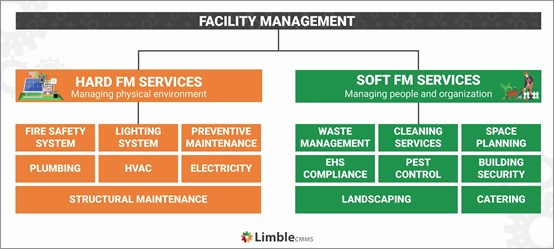The environment in which we live and work significantly affects our health, safety, and general well-being. Therefore, it’s unsurprising that factors relating to the work environment can have notable impacts on employees, including their productivity levels.

During the pandemic, this has become even more obvious, and companies needed to invest even more resources and planning into workers’ health and safety. Sound and effective facilities management is critically important in ensuring that the productivity of employees is not adversely impacted due to poor working conditions.
This article will explore some of the important factors that determine employee mobility, comfort, and safety within their working environment and how that impacts their productivity. This will include hard and soft facilities management services, thereby encompassing the management of the physical environment and people and the organization.

How Facilities Impact Employee Productivity
The state of facilities management, both hard and soft, can greatly impact employee productivity. A 2017 research project of 1,000 U.K.-based office workers and 50 facilities management experts titled “Wellness Together” and carried out by Sapio Research found a strong causal link between employees’ performance and their working environment.
Facilities-related working conditions and factors such as illumination, air quality, noise, work design, ease of movement, and even the quality of furniture were all found to be critically important in ascertaining whether employees felt appreciated and, therefore, productive and even innovative.
For American business theorist Jeffrey Pfeffer, having nice-sounding “wellness” programs is simply not enough. His research on the effects of work environments on employee health and well-being found that it was the overall work environment, and the facilities in which people worked, that really made a discernible quantifiable difference to their ability to be healthier and more productive.
Pfeffer stated, “Companies that build great workplaces also improve human physical and mental health and lifespan.” It is his estimate that poor work environments cost the United States $130 billion and 125,000 deaths each year.
Facilities-Related Breakdowns
There is a host of ways in which poor facilities management, whether hard or soft, can result in breakdowns (be they of equipment or other aspects of a workplace).
For example, a malfunctioning elevator will be a nuisance for those having to take the stairs and very stressful for those unlucky to be stuck inside the elevator. Likewise, a slow or compromised Internet connection in an office building can result in people sitting idle, being entirely unable to do their work.
Many of these types of problems in a workplace can be avoided through proactive facilities maintenance.
HVAC and ‘Sick Building Syndrome’
A more multifaceted example is that of poorly functioning HVAC: It can throw up many revealing aspects of how poor facilities management can impact employee productivity. Compromised indoor air quality (IAQ) due to poor or inadequate ventilation is one culprit. Molds and fungi with exotic names, including Stachybotrys chartarum, Aspergillus, and Trichoderma, can enter a building directly or by their spores being carried in via the air. They can proliferate in wood, drywall (plaster/gypsum), upholstery, fabric, wallpaper, drapery, ceiling tiles, and carpeting.
“Sick building syndrome” (SBS) is a real thing, resulting in employees with debilitating health conditions such as increased headaches, lethargy, bouts of allergies or asthma, and even chronic fatigue. All of these can have dire impacts on employee productivity.
A comprehensive planned maintenance schedule can ensure that air filters are checked regularly, ventilation surveys are undertaken, and standing water that could facilitate mold buildup is cleared. Simply ensuring that complaints of uneven temperatures in a building or certain parts thereof are immediately acted upon can make a difference.
A clean, healthy, and hygienic HVAC system ensures an optimal work environment. Healthy, content, and comfortable employees are more likely to be productive. In fact, research by the World Green Building Council found that there could be an 8% to an 11% increase in productivity due to reduced pollutants, such as CO2, and improved overall air quality at workstations.
Health and Wellness Benefits of Good FM
Good health and wellness equate to better productivity for employees. Facilities management must make every effort to ensure that facilities are managed optimally, as the benefits to employees of a good-quality and healthy workplace are considerable.
“It’s essential that employers take the physical work environment of their employees into consideration. Employees need to feel comfortable and calm in their physical work settings to produce their best work,” Forbes noted in 2019.
Natural Lighting
Natural light through windows can also greatly contribute to improved employee health and wellness. For example, a 2018 study conducted by the Department of Design and Environmental Analysis at Cornell University found that employees seated within just 10 feet of a window reported suffering from 84% less eye strain, headaches, and blurred vision compared with when seated farther away.
Ergonomics
Ergonomics relates to the relationship between an employee and the working environment, particularly the physical conditions thereof and how they can impact an employee’s health and well-being. The way an employee sits, stands, moves around, or otherwise interacts physically with the work environment forms part of the ergonomics.
It also includes “work design”—i.e., the way in which work is conducted (always at a desk or otherwise stationary or sedentary or with greater mobility).
Poor ergonomics in a workspace can result in a plethora of different physiological ailments that negatively affect productivity. Facilities managers should be instrumental in ensuring that workplaces are ergonomically sound, from what type and quality of seating are made available to how the workplace is designed for ease of movement.
The Importance of EHS&S Compliance
Generally, compliance to the environment, health, safety, and security (EHS&S) standards should ensure a workplace that is more conducive to happier and, thus, more productive employees. Facilities management should play an important central or allied role in each and every one of these factors.
Just imagine what would happen if the facility manager didn’t have a person or a team in place (whether in-house or outsourced) to take care of all of the factors listed below.
Environmental Factors:
- General waste management on-site;
- Freshwater quality and availability;
- Ambient air quality (not to be confused with IAQ, which is in the health management domain, as below);
- Ambient noise (as opposed to indoor noise);
- Landscaping;
- Pest control; and
- Outdoor or ambient aesthetic/visual factors.
Health (Which Must Include Occupational Hygiene) Factors:
- Concentrations of hazardous biological agents (HBAs), including molds and related fungi;
- Indoor noise;
- Temperature;
- Ergonomic factors;
- Disability access and mobility;
- Illumination levels, including glare;
- Access to natural lighting; and
- On-site sanitation and cleaning.
Safety and Security Factors:
- Electrical safety compliance, including distribution boards and substations;
- Safety guards on moving or electrical equipment;
- Fire exits and access to portable fire extinguishers (PFEs);
- Fire alarms and allied fire- or emergency-related equipment;
- Means of entry and exit;
- Security for the night or isolated work;
- Safety-specific illumination; and
- Safety demarcations, including for temporary work such as scaffolding in use, etc.
Most of these factors will, when handled poorly, have a negative impact on employee performance.
Parting Thoughts
Whether relating to hard or soft facilities management, the FM function does not operate in a vacuum. The needs of employees in any workplace need to be taken into consideration, and management must adhere to that principle at all times. Failure to do so could be very costly to an organization’s bottom line.
The empirical research and simple common sense both form the same conclusion: Provide employees with clean, healthy, and safe facilities and working conditions, and they will be more productive. As with so much to do with facilities management, prevention is always better than cure.
Bryan Christiansen is the founder and CEO of Limble CMMS. Limble is a modern, easy-to-use mobile CMMS software designed to take the stress and chaos out of maintenance by helping managers organize, automate, and streamline their maintenance operations.
